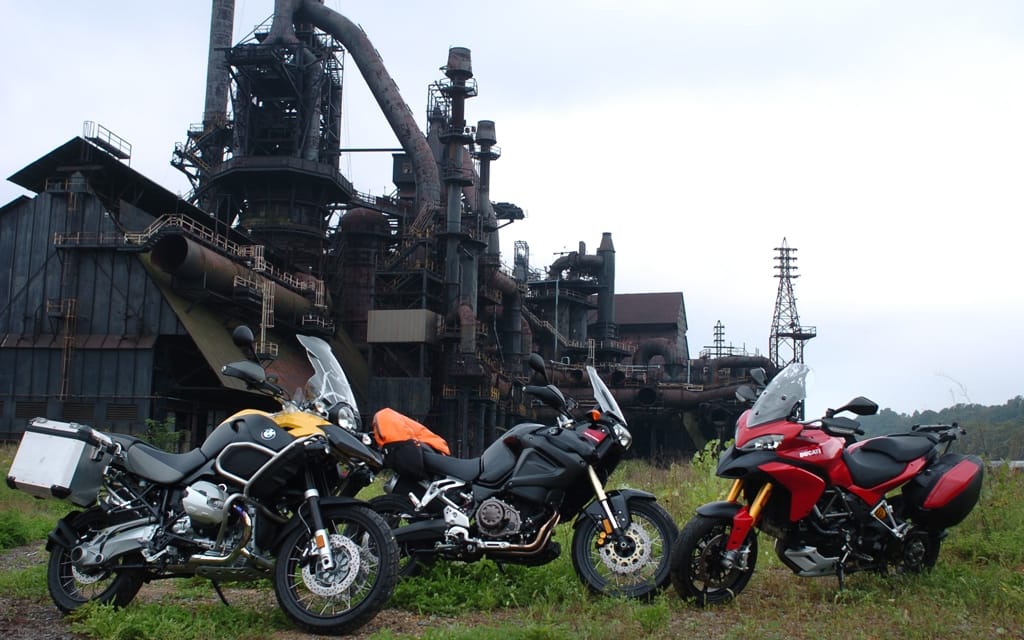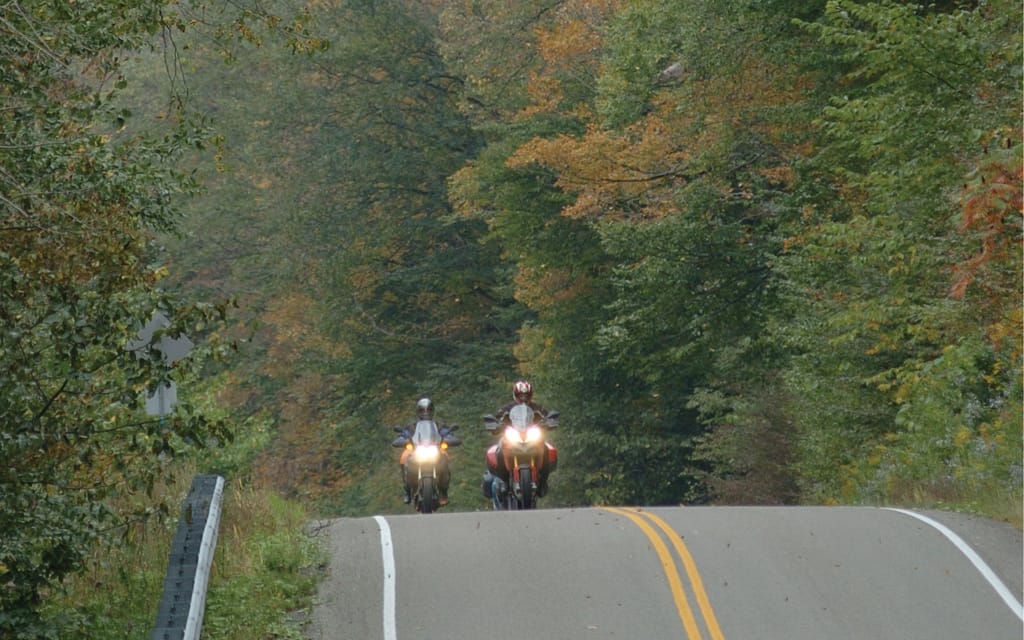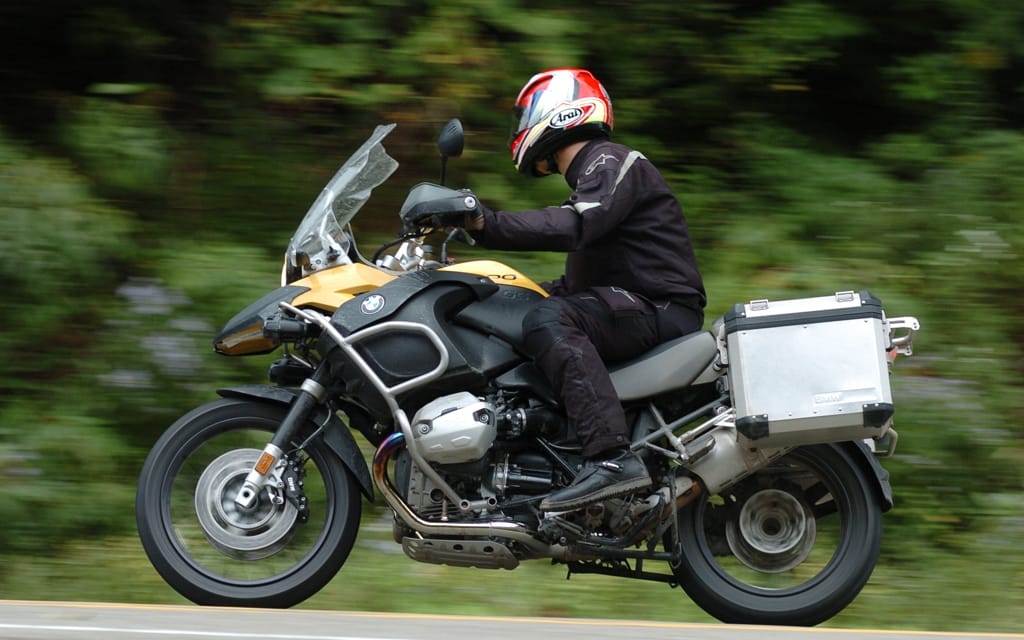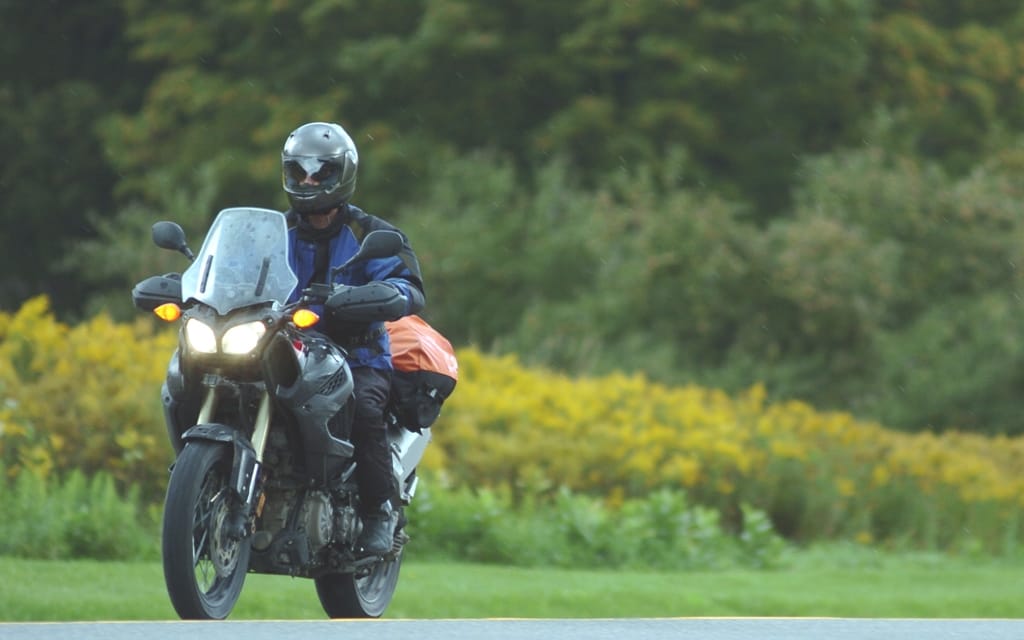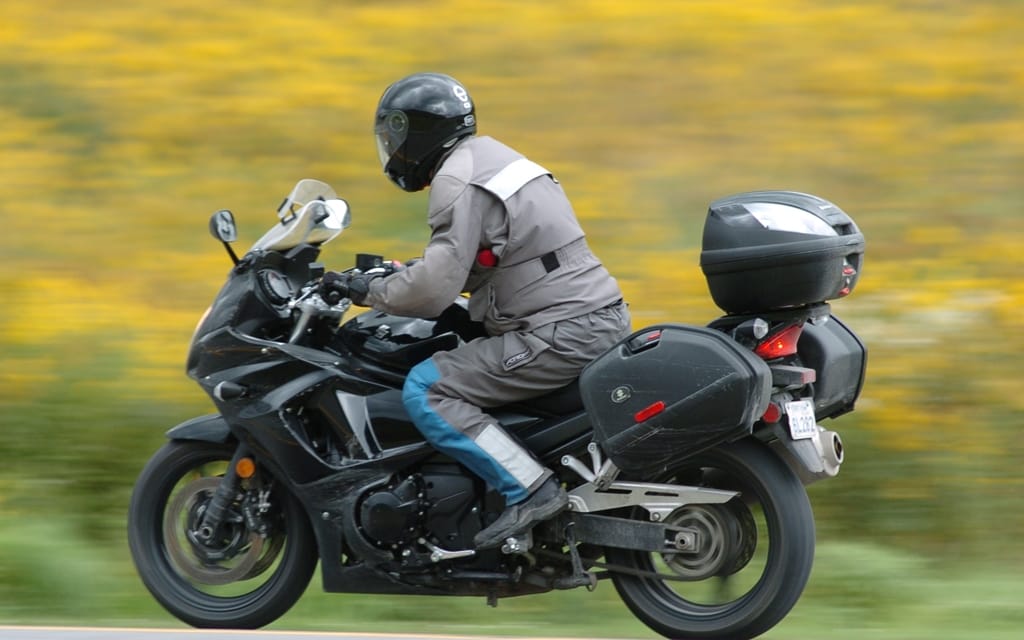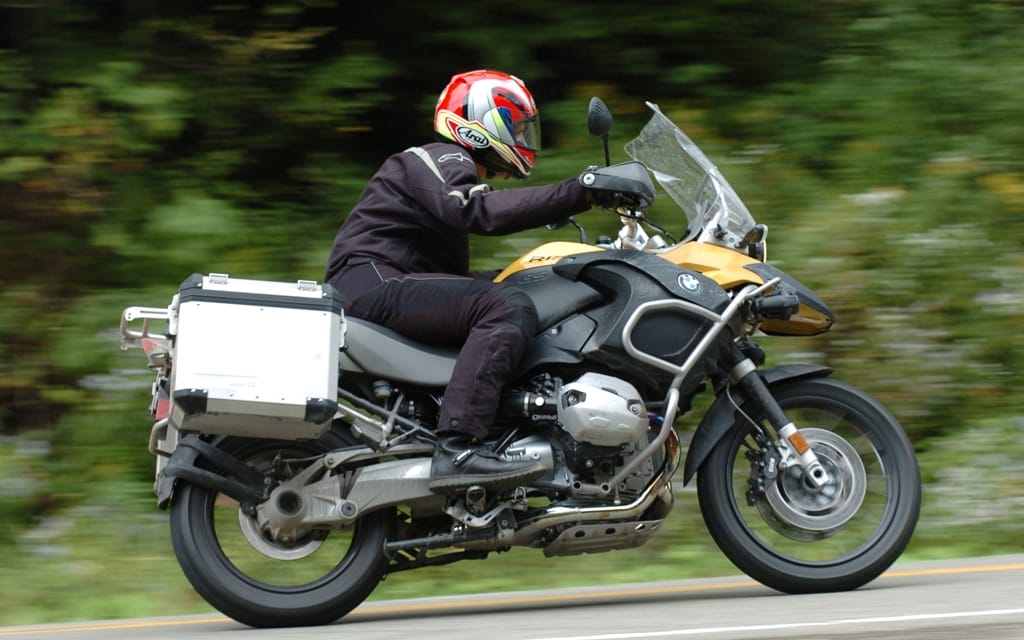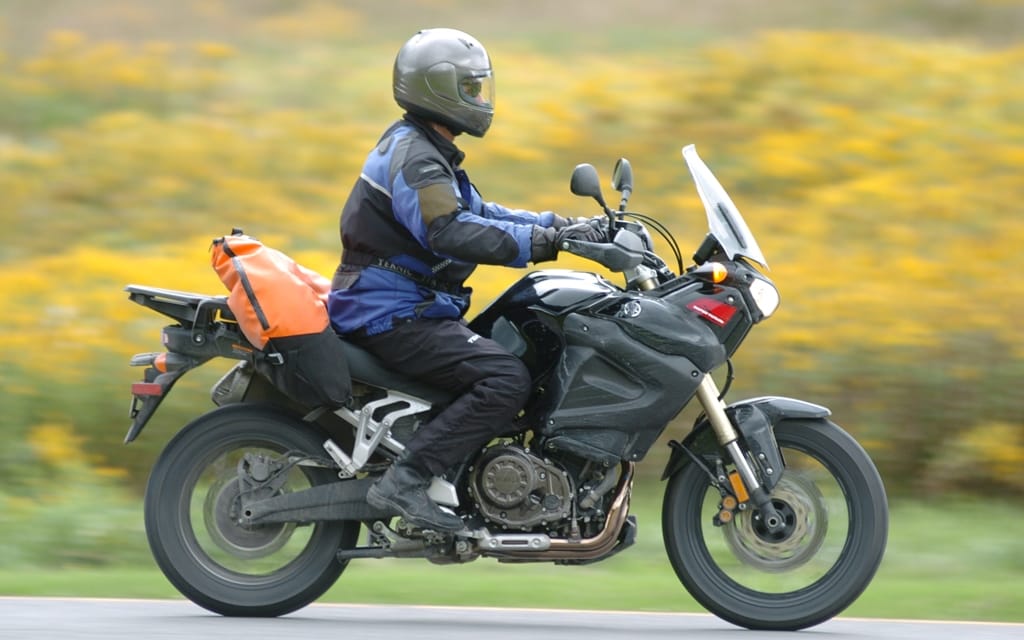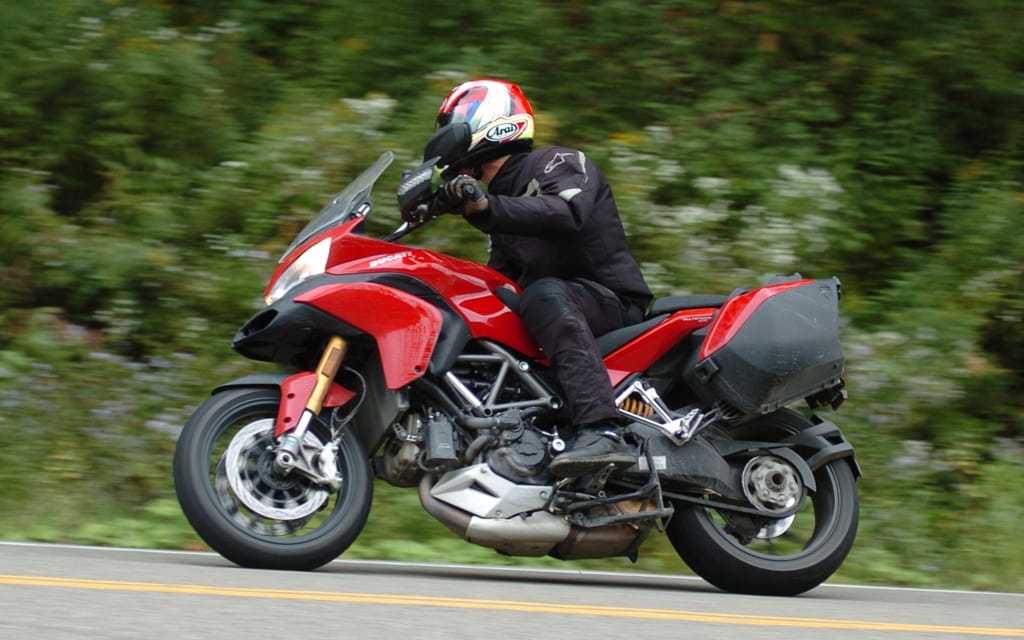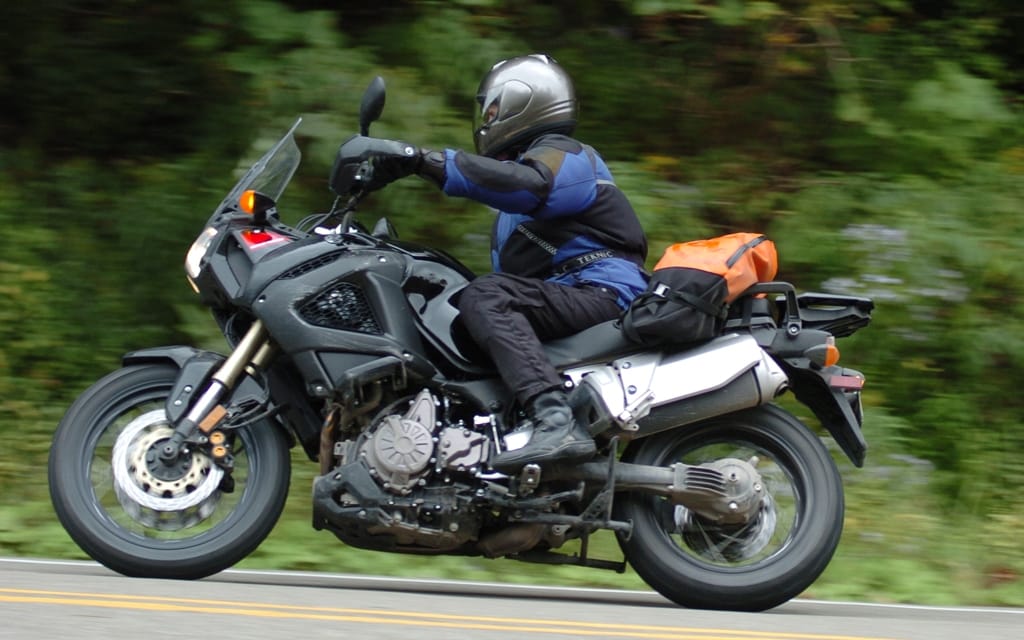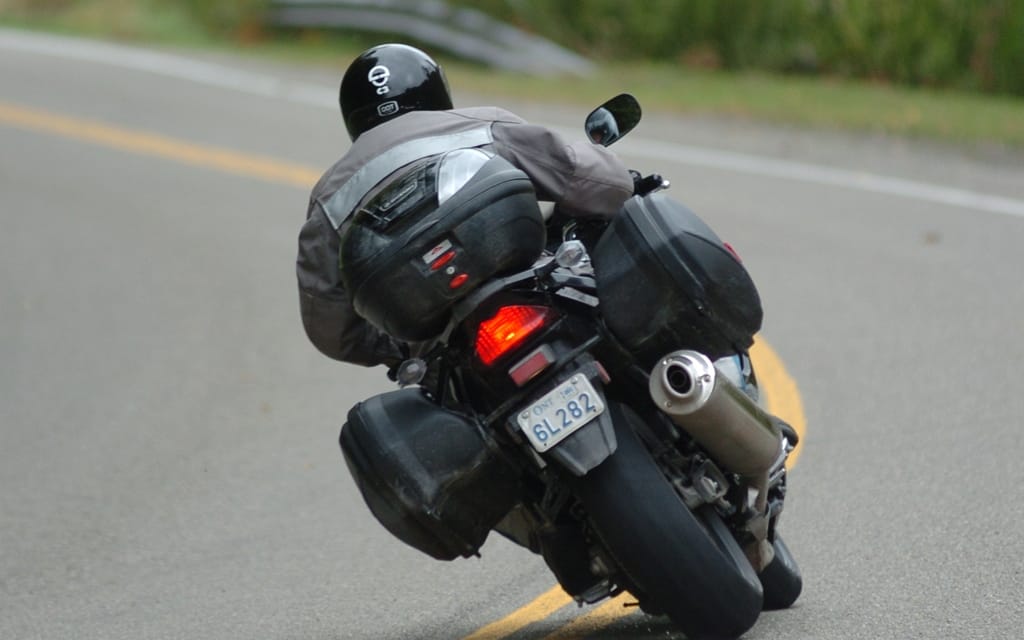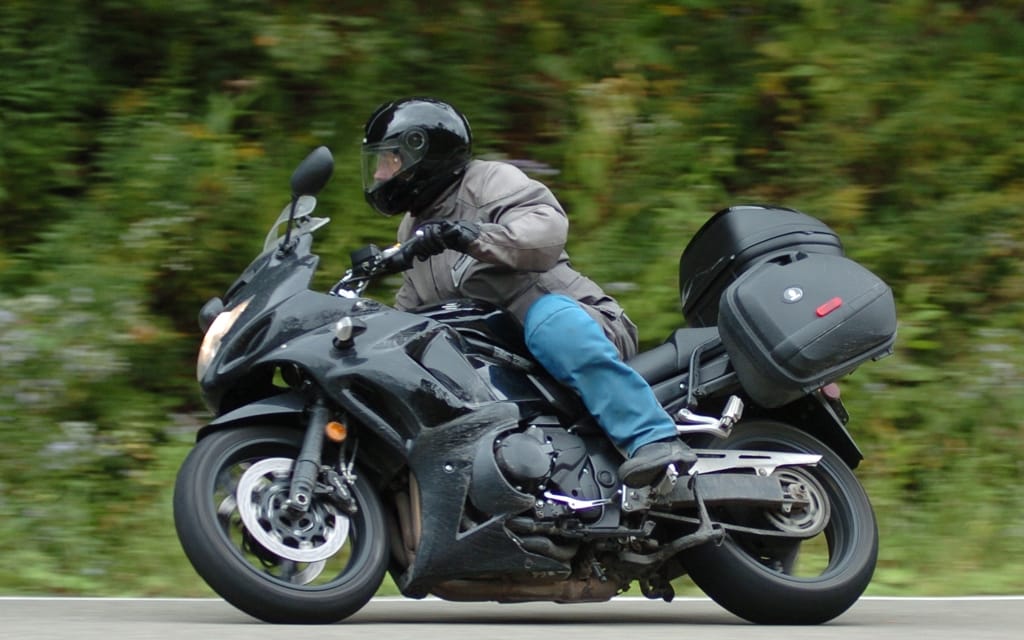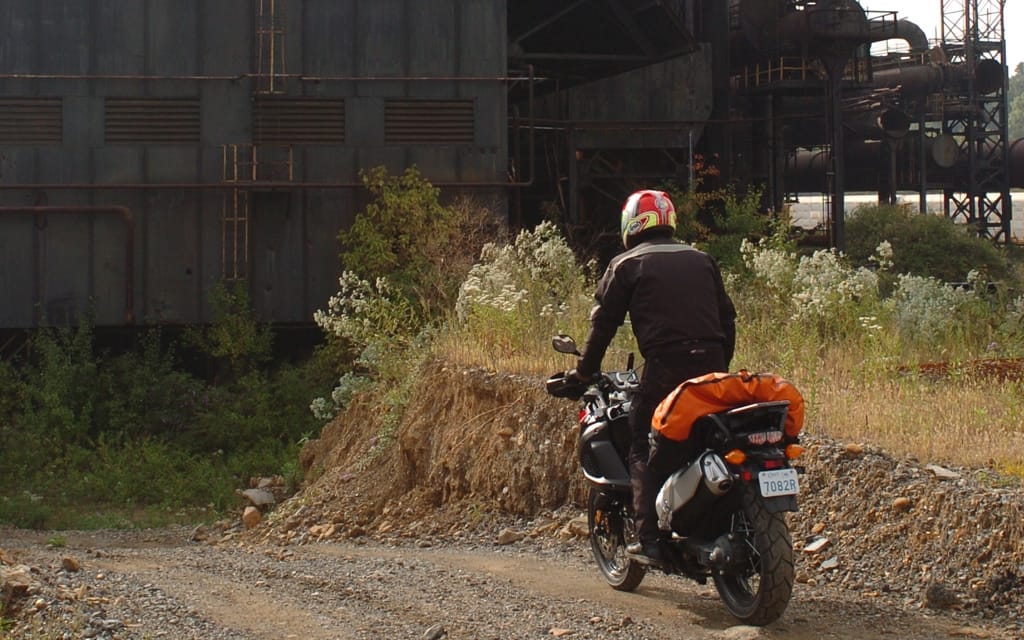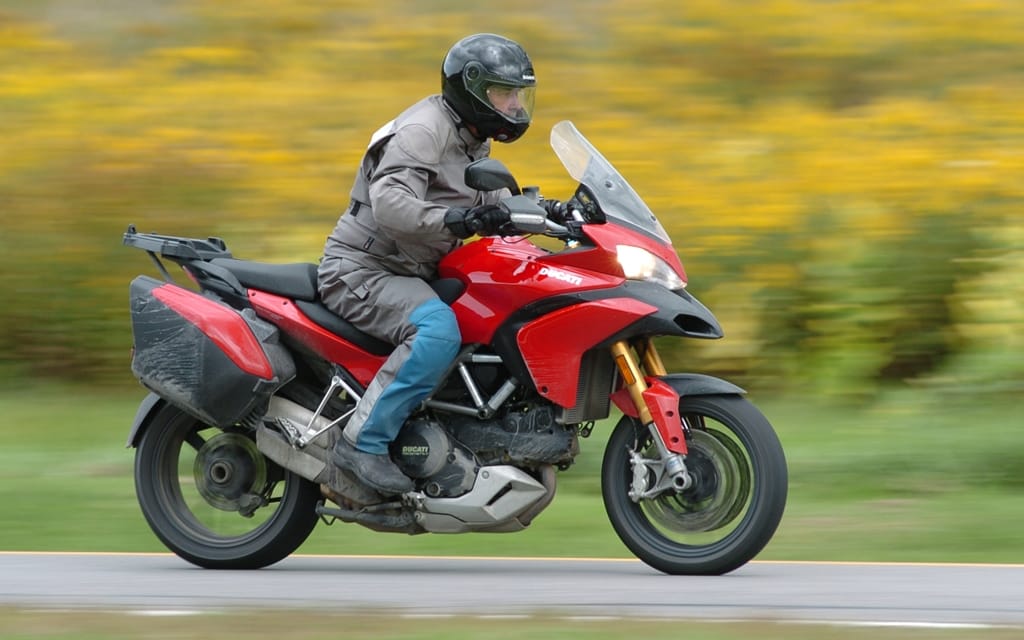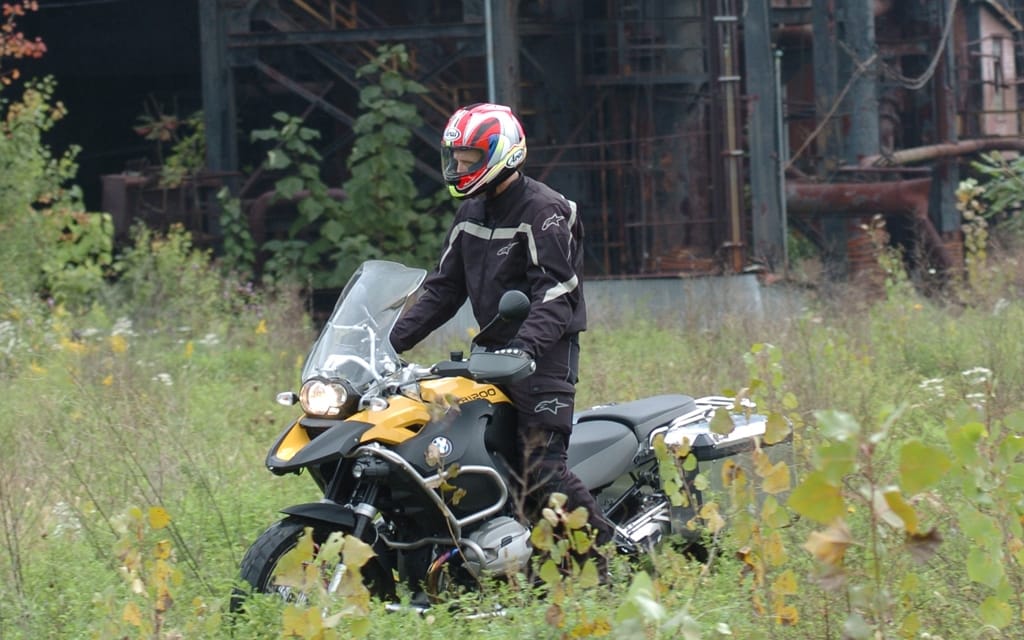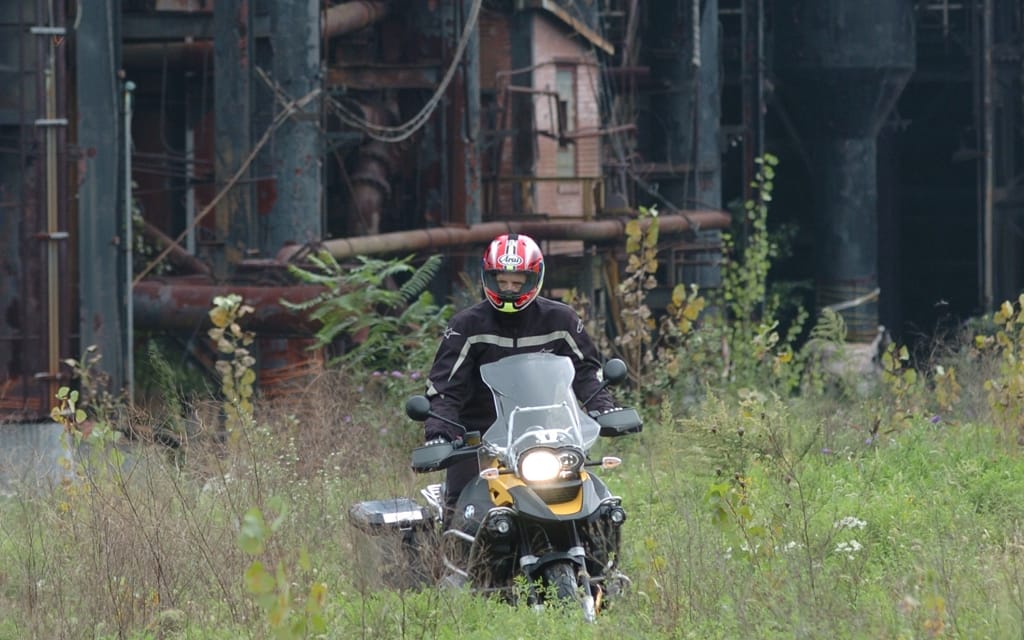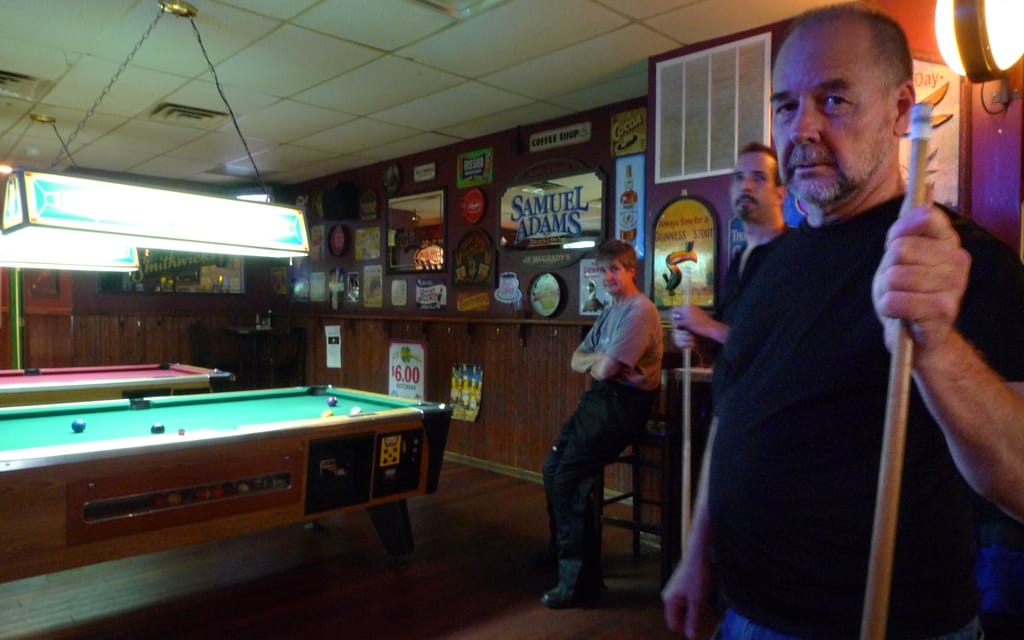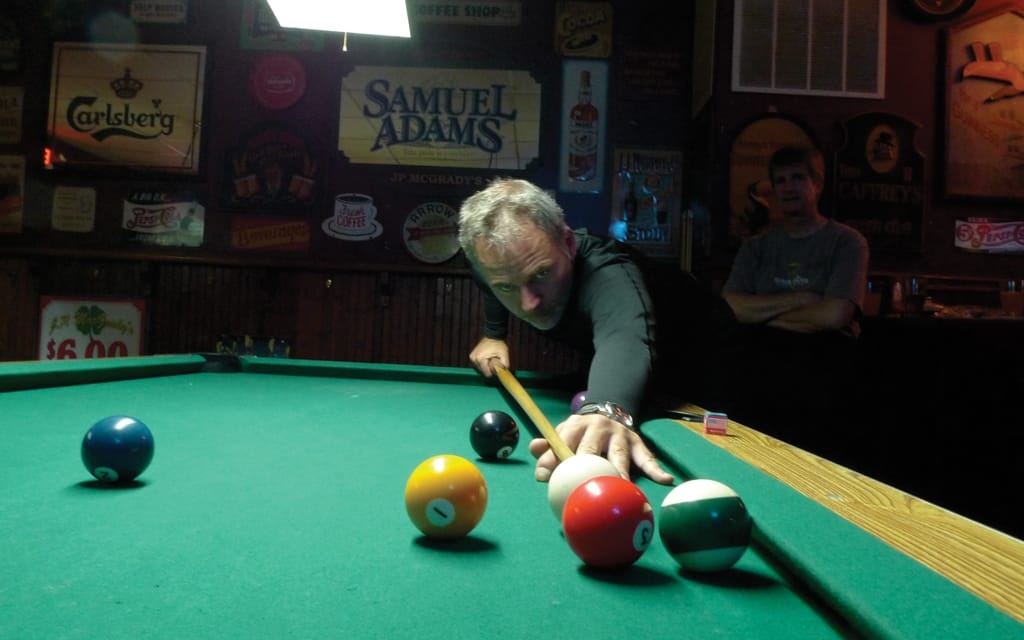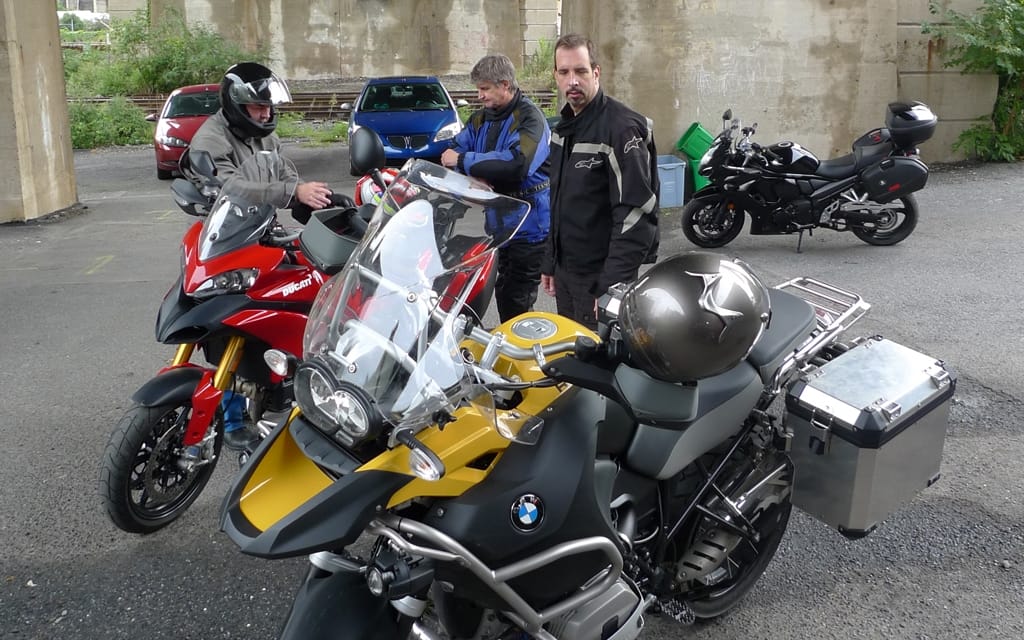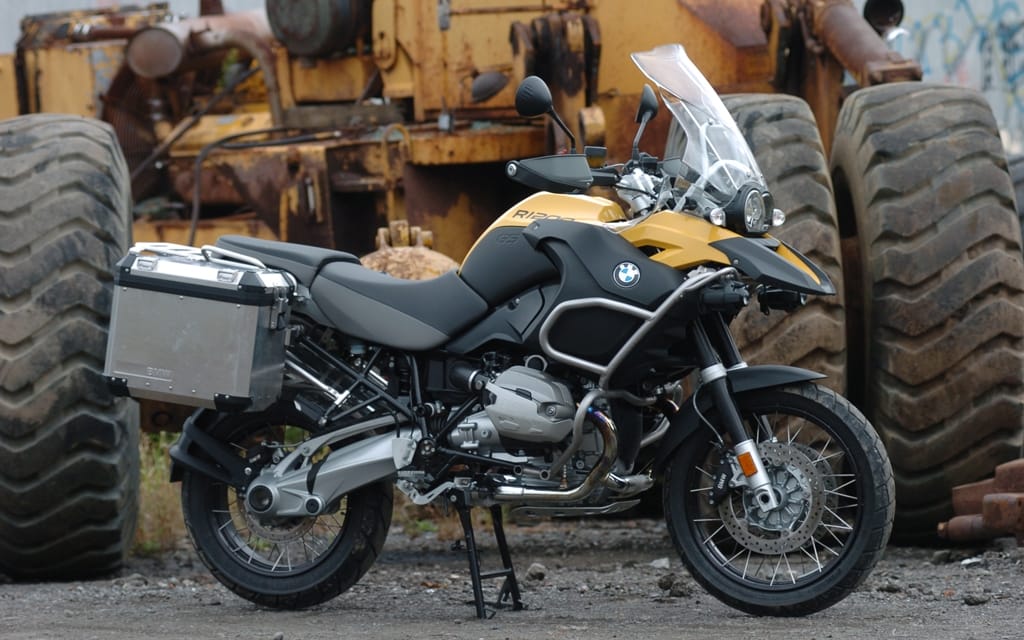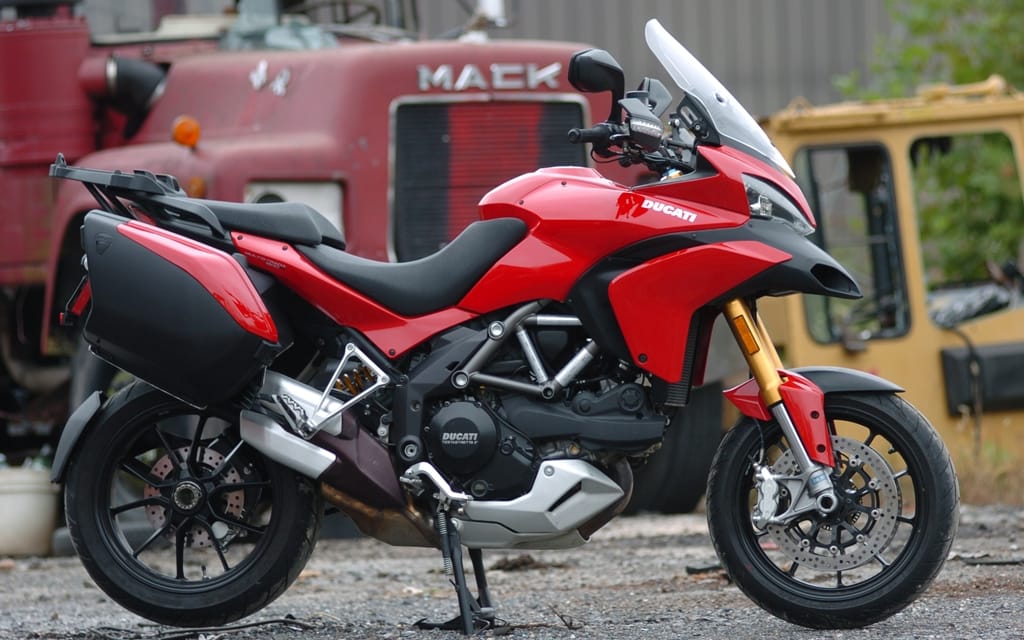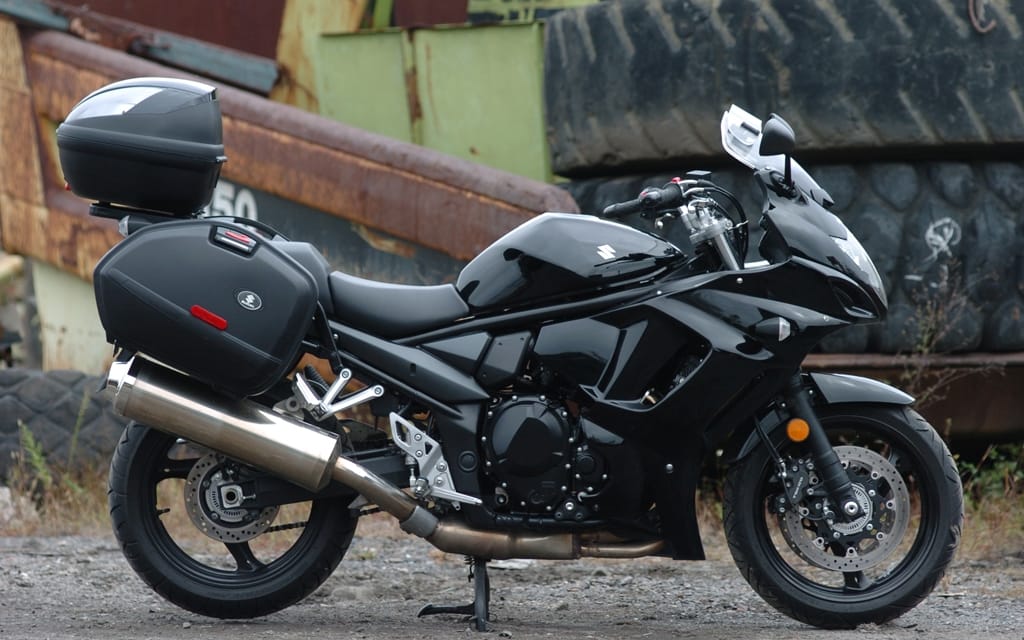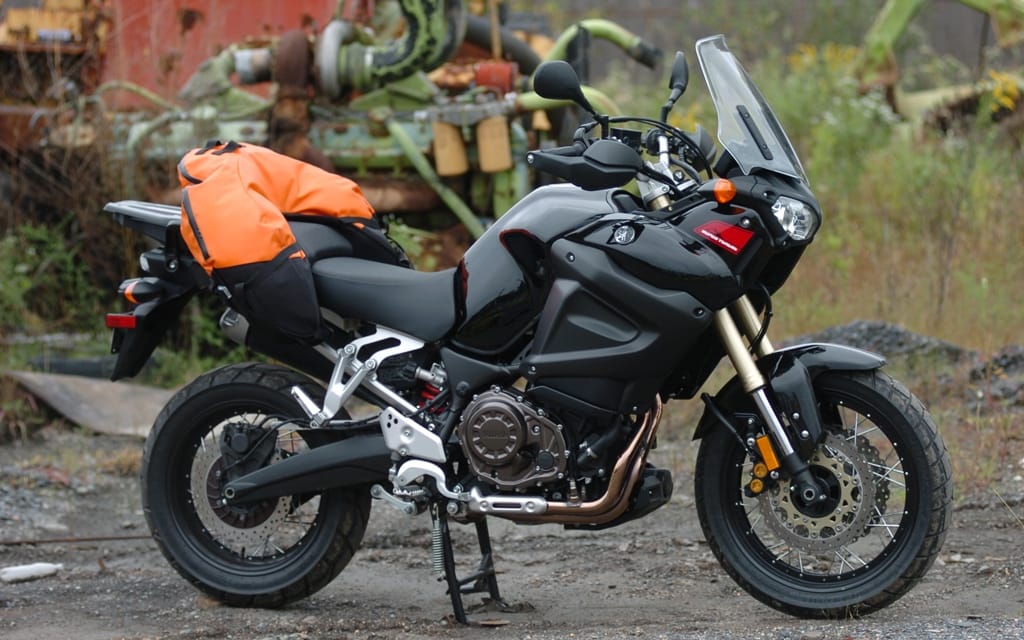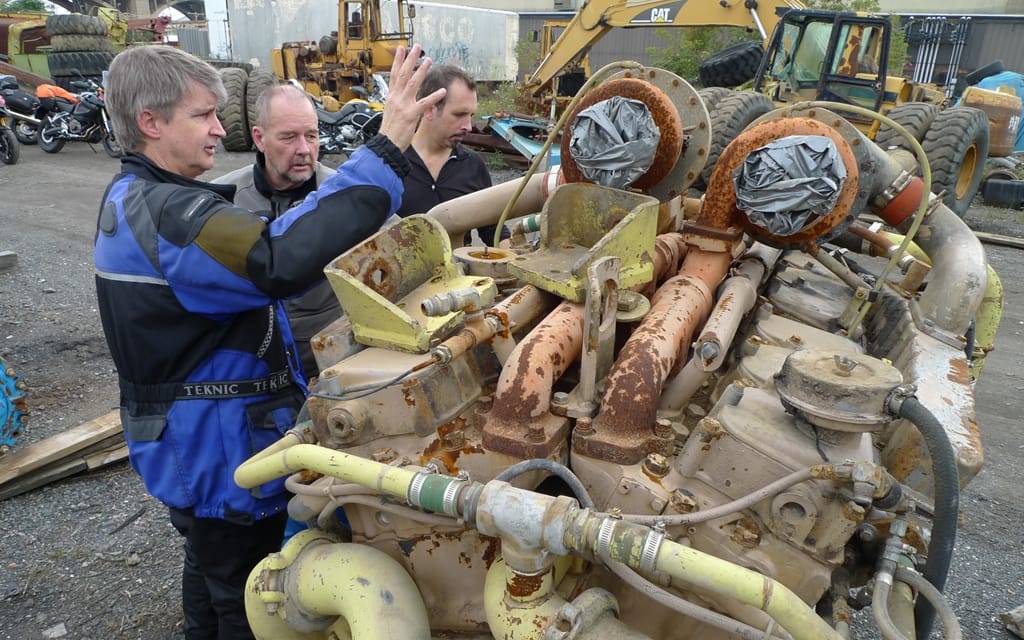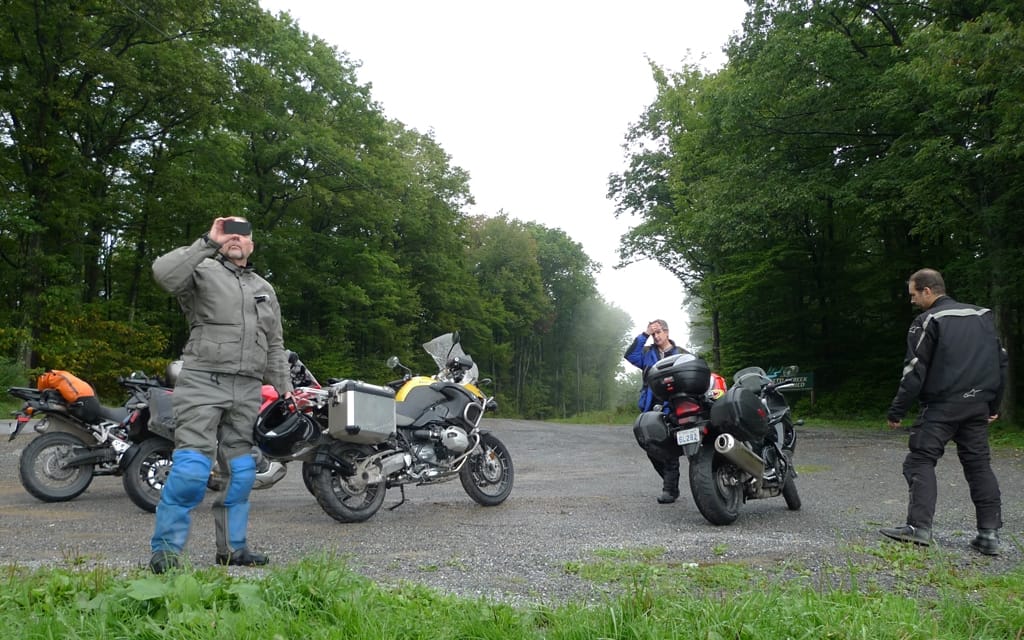The 2011 Fall Tour began as ride into America’s rust belt. That’s not how it ended.
The hardest thing is getting out the door. In the parking lot, four people are telling stories and shuffling clothing into panniers. Tim Poupore, who has rarely ridden with the three of us, isn’t quit sure where he fits into all of this. He looks to me for guidance but I’m not able to offer much. I’m pondering whether my computer should go into the pannier of the BMW that nestles against the muffler or if putting the camera bag next to the heat would be safer. I try to remember if film is affected by heat but realize I haven’t used a film camera in years. Can a pixel be upended by heat?
Onto the road and the first two-three-four-five upshift gives me a lift. We’re on the road. But this is Toronto, and before we’re halfway up the Don Valley Parkway there is a five-four-three-two down-shift. Traffic. And when traffic lightens and visors are snapped down and the pace is picked up and a sense of purpose returns, we’re forced to slow. Construction. Feet-down on the 401, I look over at Derreck Roemer and he is hungry. I can tell because we’ve travelled together for years and when he’s hungry and I ask him a question he doesn’t make eye contact but answers to the space above my head. He talks to my thought-bubble. We stop for lunch well past noon and Poupore, Roemer, and Thornton bury their heads in their phones. We’re 100 kilometres out of the city and it’s like they’ve paddled the Northwest Passage and are reconnecting with loved ones desperate for news of their whereabouts. I sit and wonder what I’m going to write about if nobody talks to me. Then the food arrives and when mouths are full the conversation begins.
The 401 isn’t just a highway, it’s the road that’s taken me away from home, to girlfriends and to deathbeds. I’ve ridden it on the far side of 200 km/h outrunning rain on sportbikes and I’ve plugged up the right hand lane going camping with my kid in my gutless VW bus. With the exception of a few brief stretches (the road arcs next to an embankment east of Cobourg and cuts through limestone footings at Kingston) it’s an ugly road. And now that the last of the Expo ’67-era service centres with their domed ceilings have been flattened and replaced with a one-size-fits-all On Route (do you get it? On, as in Ontario?) mini-mall, any one section of the road is indistinguishable from any other.
Along the highway we hammer as fast as we dare. Tractor-trailers in the province are restricted to 105 km/h. Fitting engines with governors was done, I presume, to emasculate truck drivers by banning them to the slow lane so they can’t mix it up with the over-caffeinated rest of us. But the truckers won’t have any part of it. When they see the tanker truck ahead dig in to scale a grade and slow to 103 km/h they jump into the left lane and the pass can take 10 kilometres. Traffic behind bunches up like stockcars behind the pace car and when the lane finally clears the race is on. Momentum is regained but then we have to stop for gas. And washroom breaks. Out come the phones.
Eighty percent of the Canadian population lives within 100 miles of the U.S. border. But if we’re stuck along a narrow line hoping to get whatever heat drifts across, Americans have the freedom to move wherever they want. If they don’t want winter they don’t have to take it. If they want an arid climate to soothe aging bones they’ve got that too. What American would choose to live so far north that they’re backed up against the Canadian border? The towns and farms that stretch along Interstate 81 give the answer: not many, and the few that do likely have no option. Trailer homes (way too far north for trailer homes) perch on bald lots with bicycles and half-tons and satellite dishes turned to the southern sky to pick up something, anything. We were hoping to make it to Bethlehem, Pennsylvania, by nightfall, but the light is weak and I have a dull headache that makes everything smell like diesel.
And then I realize I do smell diesel. I’d noticed a few miles back that the wet pavement was not a palette of black and grey punctuated by white-painted lines, as it should be. No, the road was the acid-trip purple and magenta of a Grateful Dead album cover. That it’s taken so long to realize I’ve been riding on a surface as slick as a sheet of ice is alarming. Why was I so slow to notice? For 30 minutes I’ve been wiping my visor with my gloved hand to cut through the greasy film without really thinking about it. I signal and lead my followers to the exit lane for the New York State rest centre, and parked in the lot is the cause of the problem: a Greyhound bus has its engine hatch open and a kitty litter-like oil absorbent spread out on the ground beneath. The fuel tank has a hole in it, and out on the road heavy truck traffic has thrown the water and oil emulsion high into the air to fall back to earth again and onto passing motorcyclists. Derreck and Tim and I shake our heads and search for rags to clean our visors. I curse the bus and its leaky fuel tank and the slippery highway and the stink of raw diesel. Steve shoots me a blank look. “What are you talking about?” he says.
Traffic on the wet road has carried the smell of diesel far past the point at which the bus exited, and it’s not until we turn off at Syracuse, New York, that the smell seems finally to have gone. We ignore the Super 8s and Best Westerns and Holiday Inns along the highway and search for a more authentic upstate experience. I generally have a knack for finding good restaurants and quirky lodging but tonight I lead our foursome around and around on empty city streets until Derreck pulls up beside me at a light. I can’t hear what he’s saying above the Ducati’s clatter, but when the light turns green I wave him on, glad that someone else is leading. Eventually we pull into the parking lot of a regal looking old hotel and only then do I realize how tired I am. But then bad news: the Jefferson Clinton hotel has rates fit for a president spending the people’s money: nearly $400 per room for the presidential suites — the only rooms remaining. It’s late September on a Monday in the rain, I say to the woman behind the desk. Why so busy? The touring production of The Lion King is in town, she says, and the tickets are “red hot.” I curse franchised musical theatre but the woman is generous with her time and sends me out the door to a hotel in the south end of the city that has rooms, at least according to the information that appears on her computer monitor.
Her directions are simple: straight, then right, then left at the point where the road splits. We ride away and pass underneath an expressway and into a residential neighbourhood. This is not right. I turn around and cut into the lot of an old gas station. In an impatient moment the sidestand is down and my helmet is off and I stride into the office and then, when I can’t find anyone, and without really thinking (because I’m focused so intently on finding the bloody hotel) I go looking for the pump jockey in the storeroom behind the desk. “Excuse me,” I bark. Two men have their heads down over a desk, backs turned to me. They turn and the expressions on their faces are not the manufactured smiles that I expect from workers in the service industry. I am glared at, and then I wonder if I’ve done something incredibly stupid. What’s on the desk? A pound of hash? A pile of money? A knife? I hold my breath.
One of the men looks at my touring suit and me and puts it together: I’m lost in a strange city in the rain at night and I’m hungry. He leads me back through the door into the office and then outside. He confirms his suspicions by looking into the three yearning faces of my companions and points me down the street. It’s simple, he says: straight, then left, then right then left. We leave the station and queue up at the stoplight, and then I see a magical sight. A man leaves a bar, kick-starts a Harley Panhead on the sidewalk, and with a fistful of throttle bounds off the curb and along the dark street. From the light of a streetlamp I watch him grab second gear with the tank-mounted shifter and just like that he’s gone. What a wonderful sound the bike makes. The exhaust is surprisingly quiet but vintage engines are rich in mechanical noises. Listen closely and you can hear the suck-compress-power-exhaust sound of internal combustion. As the traffic light turns green I’m searching my mind for the Kerouac line that describes the couple on a bike shooting through the night. I can’t think of it but I remember this, from a recent re-read of On The Road: “They have worries, they’re counting the miles, they’re thinking about where to sleep tonight, how much money for gas, the weather, how they’ll get there — and all the time they’ll get there anyway, you see.”
I’m not so sure of Kerouac’s wisdom. A few turns later I’m lost again and we stop and Tim and Steve dig out their phones. I stand alongside, useless, defeated, trumped by a telephone. Using applications that I know nothing about (they’d laugh at me for using the word applications: everyone knows they’re apps) they plot a course and Tim (measured, methodical Tim) confidently leads us to the hotel. The woman at the front desk looks me up and down and says what I need to hear: “One hundred percent sunny tomorrow.”
In the morning we ride into the eastern end of the Rust Belt. It is raining, though I was promised sun. The Rust Belt, which stretches kidney bean-shaped from Bethlehem, Pennsylvania, in the east westward to Pittsburgh and curls northward up to Cleveland, Toledo, and Detroit, was once the manufacturing heart of America. But no more. The outsourcing of manufacturing — from household products and cars to the steel that was used to make them — has left ruins as impressive as those left by the Roman Empire. So we begin at the birthplace of Bethlehem Steel. Crossing a bridge over the Allegheny River, we see it in the distance, looming black against the horizon. A chill runs down my spine. We weave through town and catch glimpses of the abandoned mill in the spaces between buildings and at the ends of dead-end streets. It’s gloriously spooky. Finally we round the corner and read the words “Bethlehem Steel” cut in relief above the gate where workers trudged for decades into the heat and the filth of prosperity. We want to get closer, but a shiny new fence holds us back. We hop back on the bikes to weave our way closer to the furnace, a baroque assemblage of tubes and I-beams so menacing it’s impossible not to anthropomorphize it: it’s the landscape we run through in nightmares chased by whatever we fear: debt, lost love, those who would do harm to our children.
We pass manicured lawns and fenced off buildings and go overtop streets of freshly laid brick. We reach the base of the mill and our eyes flow from the top of the smokestacks down. At the base is a concert stage. Behind us is the local public television station in a building fashioned from raw steel and roughly finished concrete and styled to ape the industrial landscape that surrounds it. Adjacent to the PBS station is a cafe? where you can get a grilled sandwich or a cafe? latte. The ruins have become a destination. We go to a construction trailer and ask if we can go behind the fences to take photographs. We learn that the Sands Casino Corporation owns the site and that farther down the river a casino is on the property. A man named Joe Koch asks us our intentions. Joe is head of security but worked for 25 years at Bethlehem Steel before it closed for good. He gives me a hard look that says: “Don’t be an asshole and climb on things and hurt yourself and don’t do anything remotely stupid that would cause anyone to come down hard on me.” We shake hands and I smile and tell him that we won’t leave so much as a candy wrapper behind. He nods. Then I tell him that it’s an amazing place. He nods again.
It helps to look helpless. And no one does helpless like Steve Thornton. We are dining in a restaurant and learn, in horror, that they do not serve alcohol.You can bring your own wine or beer, but they do not sell it to you. Steve, who has until how been content to follow along and do as he has been asked, suddenly shows himself to be a leader. He corners a server, finds out the location of the local wine merchant, and bolts from the restaurant. He returns and he doesn’t look happy — they were closed. Then Steve does something or says something and for the rest of the evening we have bottomless carafes of wine that materialize as soon as the previous one is empty.
After dinner Derreck goes back to the room to work while Tim, Steve, and I go in search of a bar. We drink whisky and order from a tall waiter who looks 20 years older than he is. Tim and I are discussing (I think) our favourite Italian-American cars like the Iso Rivolta, Bizzarrini, and DeTomaso Mangusta. Tim is an industrial designer so he has theories on everything from the shape of a taillight to the volume of a doorknob. It is then that we notice Steve is missing. We walk outside and find him sitting on the steps of the building next door. “I shouldn’t have said yes to that last drink,” says Steve. “You didn’t say yes,” I inform him. “You ordered it from the bartender.” “Really,” says Steve, steadying himself against the building’s fac?e.
The next morning at breakfast I tell everyone that we’re abandoning our original plan for the trip. After witnessing Bethlehem’s conversion from mill town to casino destination I have lost interest in our venture. I have romanticized what should not be romanticized. The mills soiled the air and the water and upon their closure displaced workers who gave their sweat and their soul to these companies. My father worked in a cement plant for 35 years, so I understand the commitment of men like Joe Koch. Instead of continuing due west to Johnstown, Pennsylvania, I plot a path northwest toward State College, the home of Penn State University. State College is in the mountains, and mountains mean good roads.
Long days of riding twisty roads take on a rhythm — but it’s not a steady beat. To maintain a driver’s licence requires tempering enthusiasm through towns and where driveways are plentiful. Going fast all the time everywhere means tickets or death. But the idea of “fast” is different for everyone. At a rest stop Tim smiles and says that we’re going at a clip that he has rarely reached. I chuckle. “This is our slow pace,” I say. “If the roads were dry we’d really be moving.” Tim lowers his chin and looks me in the eye. “I’m happy then that it’s raining.”
Usually rain clouds arrive, disgorge their contents, and then move on their way. But the clouds hover overhead and only sporadically release rain. It’s maddening. “Rain, dammit,” I yell into my helmet. We crest a hill and drop down into a valley where it’s dark and wet. Then up and over another hill and it’s dry. The dry-then-wet pattern catches me out as we wind west. The sun has crawled beneath the tarp of clouds and miraculously it is hot and the roads are bone dry. The revs on the Yamaha jump and in lock-step Derreck and Steve fall in behind and we’re off. It’s our third day and only now can we cut loose. I trail brake late into a corner and as soon I see the exit I’m back on the gas and off again. The second rider in queue has the benefit of using the first rider to judge speed and warn of hazards. Derreck buzzes my tail end and shows increased speed and better form after some racetrack time this summer. And then it happens, as I knew it would. There is a line in the road, as clearly defined as if it were drawn in chalk, where the dry road turns wet. Unfortunately it’s in a tight corner without a sightline to the exit. I can’t pick the bike up and run wide because who knows what’s there. I hold my line, feel the tires squirm, look where I want to go and hold my breath. And then I’m through. I breathe. A deer appears and bolts across the road. From Steve’s position third in line it looks like it’s right in front of me, he tells me later, when really it was 20 metres ahead. But it’s close enough. I slow. That’s enough for today.
Other than decent coffee (complimentary Wifi has drawn the telephones out and silenced my companions) State College is a letdown. The college girls are swathed in sweats and show the effects of too many high-calorie drinks from a well-known coffee chain. But that’s not the real problem. Tim and Derreck and Steve are trying to find us lodging but there is none. A job fair at the university has filled every room within a 30-mile radius. Tim finds us a place in Altoona and we’re off again. My morale has bottomed out. I spotted an Indian restaurant in State College and I know that Altoona (I can tell just by the sound of the name) is a fast-food kind of town. After a dispiriting ride of an hour we arrive and check into a dispiriting motel. We eat Mexican- by-way-of-Altoona food and the lads order tequila. I sit out for this round.
By midday on Thursday, our second last day on the road, we’re at the base of Pennsylvania Route 44. A website of the best motorcycling roads in Pennsylvania rates it near the top. As soon as we’re underway we know it’s a gem, and very much unlike what we’ve ridden through on the rest of the trip. The road cuts through dark forests and the landscape takes on an ominous feel. The only vehicles we meet are logging trucks and half-tons. I drop a foot off a peg to feel the road surface. My boot glides along the pavement as if on ice. Minutes later we come upon a red sedan resting on its roof in the middle of the road. A car that has already come upon the accident has stopped and pulled ahead. Two men, one with a red mark on his forehead, stand in the road. They look stunned. We stop, want to help, but we are not needed, so we carry on, slower than before.
Ellicottville, New York, exhausted, but quietly elated. The roads we were looking for finally materialized, the rain mostly held off and the food at the bistro on the main street was hot and good. And that’s where I’ll end it, this Fall Tour story. I could tell you about the next day, with its high winds and blinding mist and driving rain, but it’s a memory that hardly needs to be revived, and even now, dry and warm, I’d find no comfort in its telling.
DERRECK ROEMER ON THE DUCATI MULTISTRADA 1200
Just over two hours into our Fall Tour, the Multistrada refused to start. Everything was fine until we stopped for lunch, and then the Ducati’s LCD display stopped coming to life when I pushed the large ignition button located where you’d normally insert a key. Instead, as if I were attempting to withdraw money from an ATM, the Multistrada’s digital screen asked for a pin. Apparently the bike’s computer could no longer read the chip embedded in its key fob and needed me to manually input a code that would remove its security firewall and allow me to start it. I punched in the numbers that I had memorized from last year’s Multistrada press bike and luckily they worked — we were back in business.
From then on the Multistrada demanded its pin at every start-up. The ignition fob’s battery was dead, we learned from Ducati’s Steve Hicks upon our return — a result of him habitually leaving the fob on the bike, where it’s constantly active and loses its juice accordingly; something no regular owner would ever do (at least not intentionally).
I first test-rode the S Sport in early 2010 and was immediately taken by its comfort, power, and confidence-inspiring road manners — courtesy its electronically adjustable Öhlins suspension. With exception of the disappointingly faulty panniers that came with our S Touring tester on last year’s Fall Tour, I’ve had nothing but high praise for Ducati’s all-rounder. I love the bike so much, in fact, that not long ago I dramatically increased my debt load and bought my own S Touring model. (How I Became a Ducatista: Sept/Oct CC)
The leaky pannier lids of last year’s model have thankfully been fixed for 2011. Rather than completely redesign the luggage, Ducati added a keyless plastic clasp to each case’s two top corners, the places where daylight shone through the gap between body and lid last year. Closing the extra two clasps, along with the primary locking one, now ensures that each pannier is completely sealed. It’s not the most elegant solution, but it does work. A check for leaks after a two-hour ride through torrential rains at the end of our tour showed that last year’s accessory garbage bag liners were no longer required.
With last year’s leaky luggage fixed, I was confident the Multistrada, even with this one’s mildly irritating ignition issue, would come out on top as the best of this year’s Fall Tour rides. But after lunch on the first day it became apparent that our Ducati tester was not running as it should. Like many Ducatis, the Multistrada is geared tall, and pottering through school zones and down small-town main streets requires a fair amount of clutch slipping at the best of times, but our particular tester was further hampered by an unwillingness to fuel cleanly at engine speeds below 4,000 rpm. And when set to enduro mode the next day, during our brief off-road session on the grounds of Bethlehem’s derelict steel mill, the Multistrada’s behaviour was even more disturbing. It refused to accept throttle and coughed and sputtered heavily as Neil tried to power it along a dirt path past my video camera.
The BMW, on the other hand, was incredibly well behaved during our off-road shoot. Having only previously ridden the mega adventure tourer on the highway, I was surprised at how easily I could ply it through tall grass over rocky terrain. Its heavy silhouette belies remarkable nimbleness (of the four machines only the Multistrada is lighter) as two days later I found myself throwing the Beemer into the tight bends of Pennsylvania’s Route 44 with confident gusto. It’s a fine machine, but its stolid workhorse character ultimately left me unmoved.
The Suzuki also acquitted itself extremely well on Route 44, as I expected it would, being a traditional sport tourer, and its ABS brakes saved me from running into Neil during a tight turn that I entered faster than he did. Its silky smooth inline four is so flexible and forgiving that you can put it in top gear and almost ride at any speed. The Suzuki is an incredibly easy bike to ride, but it often left me feeling unengaged and divorced from the road.
Since our Multistrada was having issues, I have to say that the Super Ténéré was for me the most enjoyable bike to ride on this year’s Fall Tour. It may show its substantial weight when pushing it around the parking lot, but at speed its bulk was not noticeable. Its torquey parallel twin is mellower than the Ducati mill but has a sweet raspy quality that I liked. On the highway I found the Yamaha comfortable with plenty of power for easy passing, and, in the twisties north of Allentown, a quick-steering, confident back-road tourer.
Pity, then, that I was back on our Multistrada for the final leg of our journey back to Toronto. I say it was a pity that I was back on the machine I claim to love because its fuelling issues combined with slow-moving rush hour traffic in heavy rain made the journey additionally taxing. My clutch hand started to ache, and, having been away from my own Multistrada for five days, I began to fret about it perhaps actually being this unpleasant too. An hour later I was back on my own bike and relieved to find that this was not at all the case. My Multistrada felt like a completely different machine. Fuelling was smooth, acceleration crisp, and even the tall gearing didn’t feel so tall. Our tester, it seemed, was in need of a tune-up — or maybe just a software upgrade.
NEIL GRAHAM ON THE BMW R1200GS ADVENTURE
I have a very long inseam. I have never paid any attention to the seat heights of motorcycles, and prior to testing any new machine that is seat-height-adjustable I invariably set it to its highest setting before I even throw a leg over — and I’ve never yet had a problem flatfooting any machine. Until now. On the GS Adventure the heels of both feet do not touch the ground. And at this moment I’m thankful that the battering-ram fac?e of the GS is only that: a fac?e.
The GS, with its metal panniers, substantial crash bars, cock-eyed headlights and tongue-depressor visage, is a motorcycle built for the apocalypse. And it’s tall: on its centrestand in my garage it looks the height of my VW Bus but a whole lot meaner. But the moment the GS is clicked into gear (which can be an odd sensation, as sometimes there is no audible click at all) and the clutch released it transforms into a light-footed companion. Indeed the wonder of the 1200GS is that its agility on the move seems impossible given how substantial it is at rest. From U-turns on narrow country lanes to tight turns on winding back roads, it is utterly unflappable — and comfortable, too. The relationship of seat to handlebar to footpegs makes it as close to sitting in Herman Miller’s Aeron chair as you’ll find on any motorcycle.
Despite BMW’s attempt a few years ago to infuse the GS’s exhaust note with a more visceral growl, it lacks the Yamaha’s rasp or the Ducati’s hammer-heavy beat — the GS’s boxer-engine has a guttural chortle that seems anything but sporting. But it is an engine that cannot be dismissed. Its traditional flat-twin configuration boasts a characteristic nearly extinct from today’s light-flywheel, high-revving engines: momentum. Once the GS is up to speed it’s the kind of machine that you don’t want to stop. It’s so stable, nimble, and comfortable that you can exploit the fuel tank’s epic capacity. And the worse the road gets the more the GS’s strengths come to the fore. On Pennsylvania’s Route 44 the slick roads don’t seem quite so slippery from the saddle of the GS because I can lug the engine in a tall gear and never risk spinning up a rear tire. And through the broad handlebar I can sense when the front wheel is being pried too hard to take a corner.
But, alas, it’s not perfect. The Adventure incarnation of the GS is, from my perspective, a too-extreme version of a great idea. The standard R1200GS does all of what this bike does but it’s cheaper, lower to the ground, and more of an everyday motorcycle. The Adventure is for two types of buyers. The first kind will ride it deep into the heart of Mexico and live for months on refried beans and existential literature. The second kind of buyer will rarely leave the confines of the city but will harbour fantasies of living the lifestyle of the first kind of buyer. The first buyer should buy the Adventure; the second should buy the standard GS.
As the man with the corporate credit card and the highest-ranking name on the masthead of the four Fall Tour participants, I claimed the GS as mine on the merits of the steamer-trunk panniers. Top-access bags like the GS’s make so much sense that I don’t understand why the majority of motorcycle luggage continues to hinge open on the vertical axis. Would you take a traditional suitcase and open it up while it’s standing vertically? Of course not, you’d lay it down and hinge the top open so the contents don’t fall out. But, alas (again), they’re not perfect. The lids aren’t hinged but have a tether wire so instead of being set down out of the way they bang and clatter and slip off the seat and get in the way. And while the mounting system to affix the bags to the bike is straightforward and secure, neither lock functioned properly and the bags could be removed with or without use of the key. My final grievance is the most serious: where is the carrying handle? If you’re going to make a machine that trades on rationality as its reason for being, then how can you forget to weld a handle on the top of the bag so that it isn’t necessary to carry them up to your room like you’re wrestling a drunk up a flight of stairs?
The GS’s challengers had their struggles, too. This was to be the Multistrada’s year, as we included it in the Fall Tour for a second straight year so we could see if Ducati solved the leaky pannier problem (they have). Unfortunately, this year’s bike was let down by a fuelling glitch that exacerbated its tall gearing. Press bikes lead hard lives and it likely only needed a freshening-up, but we have to review what we’re given. The Suzuki was the dark horse in this crowd, and its muscular engine and spot-on fuelling made a mockery of the Ducati’s bucking and coughing — it could be lugged though towns in sixth year while the Multistrada protested in second. But, alas (again), the Suzuki has a little less legroom than the others and its to-a-price-point suspension couldn’t match the action of the other bikes. The Yamaha was the real unknown prior to this trip and a bit of an enigma. It is, in the Japanese way, a flawless, faultless motorcycle. But it’s a bit heavy and power is a bit soft compared to the BMW. Yamaha has made a very good bike but I was hoping for the next step in the genre, the next leap forward that would send KTM and BMW fleeing back to their design studios to get back in the hunt.
It’s telling of the competence of the four bikes on our tour that I really didn’t care which one I was riding, and I would have traded any one for any other if the swap could have guaranteed just a little more sunshine.
STEVE THORNTON ON THE SUZUKI GSX-F
When Neil told me we’d take a Suzuki Bandit on this fall tour, I was a little confused; surely he meant the V-Strom. We would also take a Multistrada, an R1200GS, and a Super Ténéré, all of which the V-Strom resembles, so the Bandit didn’t make sense.
Actually, it’s a GSX-F, not a Bandit, though the name is the only difference between the two. But, as things developed, it was the bike that I again and again turned to when given a choice. I just found the Suzuki GSX-F easy, in every way. In that, it provided an ideal counterpoint to the so-called enduro machines, which were approximately the equal of the sport-touring Suzuki on pavement, but demanded more skill, confidence, and daring from their riders.
The GSX-F is a sport-touring motor- cycle: its profile is similar to a sportbike’s, its handgrips are low enough to invite a forward lean, its bodywork is aerodynamically sharp, its rear tire is a wide Bridgestone Battlax and its engine is a powerful in-line four.
While the three enduro-type motorcycles were so tall that I felt precarious on them, the Suzuki let me put both feet on the ground, which amplified my low-speed confidence. Given that confidence, I was able to enjoy the bike’s ample power and sport-touring accommodations. The powerband is flat and useful — you could snap the throttle open at 3,000 rpm in high gear and get a satisfying lunge, and at higher revs an open throttle would unleash an impressive rush of acceleration. The seating position, with a slight forward lean and a slight angle back for the lower legs, was comfortable at speed and not uncomfortable in slow motion. The small front fairing allowed just enough air past it to provide upper body support for the rider at speed.
The Suzuki was also equipped with ABS, which was another surprise, since this is considered a sort of bargain-basement sport tourer; and a shift light, which seemed out of place (and which I did not use). On those wet, leafy Pennsylvania roads, anti-skid braking was a further source of confidence.
One of the riders complained that the Suzuki was difficult to manoeuvre on twisty roads, in part because the handlebar is narrower than on the adventure bikes, but when I chased Neil and Derreck down a curving road, the GSX-F felt composed and light. It’s not perfect; it would stand up in a turn if you didn’t apply consistent counter-steering pressure. And it was fitted with a second lip on the windscreen, a moveable piece that can be raised or lowered while riding to change the flow of air. It’s attached to the windscreen by ratcheting hinges, and it moves through two axes at once, rotating slightly while moving up or down. It’s an awkward thing to do with one hand and the lip can be difficult to move, but it’s meant to be operated while riding, which could be distracting.
The Suzuki’s luggage, on the other hand, is pretty good. Removing the two side bags or the top case from the bike was a simple procedure: turn a key, push a large button, and pull. Attaching the bags was even easier: slide two indents over protrusions on the frame-mounted rack, and push; a loud click informs you that the bag is firmly in place. The button that you push to unlatch a side bag was at times more of an obstacle than a working component, but with a little fiddling the bags always came off quickly. They were also large enough that I offered space to other riders, and after we returned to Toronto in a blinding rainstorm, the con-tents of top case and side bags were dry.
Of the other three bikes, the BMW R1200GS Adventure upset me the most; this is a motorcycle that seems built to keep people like me away from it. Even before the tour, Neil asked me a serious question: “Is it possible that you can’t ride this bike?” The BMW’s seat is 890 mm from the ground in its low position. That’s 20 mm higher than the Yamaha Super Ténéré seat’s high position. It turned out that I could manage the BMW seat, but could only get the toe of one boot on the ground while stopped. It was a bit of a tightrope act for me, but I felt calm and confident as soon as the Beemer started moving. I don’t remember riding another motorcycle that felt that balanced and smooth at very low speeds.
The Ducati Multistrada 1200 comes with a non-adjustable seat and also felt tall in the saddle, but in fact was an inch and a half (40 mm) lower than the GS. It’s nimble and easy to ride, clearly more powerful than any of the other bikes, and is fitted with superior suspension and brakes. Yet the engine was snatchy at low speeds and the rear brake’s stopping power could have been exceeded by my own feet, were I able to get them flatly on the ground for a good drag. The Yamaha Super Ténéré is a thoroughly Japanese enduro. Its seat was the lowest (though in low position just five millimetres below the Ducati’s) its engine was tractable and powerful, and it felt light and balanced and somehow more bland than the others. Its blandness might be an effect of having fewer problems, and in the right hands the Yamaha could certainly thrill, but it never became really interesting in ways that the Ducati and BMW could.
The Suzuki, too, never became really interesting, but when we had to pound some fast miles on twisting roads, that was the bike I felt most comfortable on, and when I asked it to lean into a corner or accelerate out of one, it never failed to satisfy. Of all four bikes, the Suzuki might not be the one I’d choose to buy, but I was certainly glad that I was able to choose to ride it on our 2011 Fall Tour.
TIM POUPORE ON THE YAMAHA SUPER TÉNÉRÉ
When I asked Neil how much stuff I could bring on the Fall Tour he said “Two saddlebags each. No top cases. They’re for cameras.” I had no trouble filling a couple of bags, yet when I arrived at the CC office I counted four bikes but only six saddlebags. I imagined the lanky Mr Graham would be filling the metal crates on either side of the GS Adventure and Nuovo Ducatisto Roemer would surely claim the Multistrada. Thornton would prefer the sleek Suzuki with its Givi-like hard cases, which meant I was going to be saddled with the bagless Yamaha Super Ténéré, unfortunately delivered without its GS knock-off aluminum luggage. How’s this work, again?
Steve took a break from pre-flight tire pressure checks and gave me a Giant Loop Coyote saddlebag — a big safety-orange vinyl tube that appeared better suited to being filled with screaming kids in bathing suits than my socks and underwear. I set about finding anchor points and repacking my gear into the three fitted pouches that fit inside. It supposedly held 30 litres, which was enough for the most important half of what I had brought. As for being fairly waterproof, the fabric-backed vinyl of the bag seemed impermeable and the zipper looked like the type you see on drysuits but the hole that remained where the two sliders met was definitely not going to impede water entry in the slightest.
Visually, the Super Ténéré presents the purposeful robustness you would expect in a machine meant for adventure riding. It shares the pig-snout bluntness of KTM’s 990 Adventure rather than the aggressive hawk’s beak started by the GS and aped by the latest Multistrada, and I wouldn’t hesitate for a moment to take the Yamaha off-road. It has composite tip-over protectors at the base of the fairing that would take the brunt of a drop much as the head guards do on the standard BMW GS, without the exaggerated nerf bar arrangement of our more heavily armoured GS Adventure.
The Super Ténéré’s sidestand annoyed me from the get-go because I had to figure it out, and you shouldn’t have to figure out a sidestand. The actuator lever is nestled up close to the footpeg making it hard to swing it down with your heel. I learned to ignore the actuator and kick the stand down with my boot on the end plate, which was fine as a work-around, but it still bugged me.
Stage one of our trip involved droning along boring divided highway for hours. We swapped bikes along the way and I had the same complaint about all of them: Where’s the cruise control? These bikes are already loaded with electronics controlling traction and suspension and braking, but not one of them is prepared to give my wrist a break. Hands are the most important interface we have with motorcycles and most susceptible to cold and fatigue, and every one of us periodically shook our left hands into the wind to circulate blood while our right hands stayed glued to the bars. Two of the bikes on test had heated grips but none of the manufacturers recognize the value of cruise control on anything but big tourers.
Fatigue is exacerbated by vibration, and as you might expect the four-cylinder Suzuki was an easy winner in the smoothness category. As far as the more vibration-prone twins are concerned, I’d be tempted to place the Yamaha at the bottom of the list even with two balancing shafts, but not by much. The big parallel twin’s secondary rocking is harder to tame than the Ducati or BMW configurations, but once off the highway and into variable-throttle terrain the issue goes away and the big-bang benefits of a 270°crankshaft become immediately apparent, with the Yamaha pulling strongly and cleanly despite being slightly porky in this crowd. Nothing comes close to the Ducati, however, in terms of power and torque.
The Multistrada’s sculpted seat makes a cosy pocket that keeps the lower half of your body rocketing forward with the bike. All you have to worry about is leaning forward enough not to be left behind from the waist up. This is easy on the other bikes whose bars are farther away so extended arms can offer better leverage, but the Multistrada’s bars are quite close to the rider and this, combined with the pocketed seat, made this bike the most difficult of the bunch for me to countersteer. Every time we swapped bikes and I found myself on the Ducati, I had to remind myself that it responds well to a heavier hand.
Ergonomics played a huge part in my response to the BMW. I’ve ridden the regular GS and enjoyed it just like everyone else. It’s docile and familiar, immensely capable and a strong contender for the only bike you’d ever need, especially if your desert island is big enough to let it stretch its legs. But the height of the Brobdingnagian Adventure model is just too extreme for my measly seventy-fifth percentile body. Roemer and Graham can have it. Lilliputians like Thornton and me will stick with the standard GS.
So, my getting stuck with the bagless Super Ténéré was a blessing in disguise as it turned out to be my favourite. I’d still like to try one with the aluminum cases because, frankly, my Giant Loop luggage did not pass the dryness test. Our last leg around Lake Ontario was a long wet slog through a relentless downpour where everyone and everything got soaked. I know this is hardly typical of the Ténéré Desert, but even so I was disappointed to find a couple of inches of water standing in the bottoms of both arms of my Coyote bag. Good thing it didn’t happen on the first day.
